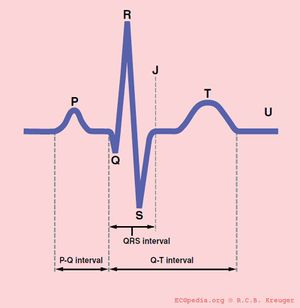Conduction
| «Step 2: Rate | Step 4: Learn how to determine the heart axis» |
The PQ interval
The PQ interval starts at the beginning of the atrial contraction and ends at the beginning of the ventricular contraction.
The PQ interval (sometimes referred to as the PR interval as a Q wave is not always present) indicates how fast the action potential is transmitted through the AV node (atrioventricular) from the atria to the ventricles. Measurement should start at the beginning of the P wave to the beginning of the QRS segment.
The normal PQ interval is between 0.12 and 0.20 seconds.
A prolonged PQ interval is a sign of a degradation of the conduction system, increased vagal tone (Bezold-Jarisch reflex), or it can be pharmacologically induced.
This is called 1st, 2nd or 3rd degree AV block.
A short PQ interval can be seen in the WPW syndrome in which a faster connection exists between the atria and the ventricles.
The QRS duration
The QRS duration indicates how fast the ventricles depolarize. The normal QRS is < 0.10 seconds
The ventricles depolarize normally within 0.10 seconds. When this is longer than 0.12 seconds, this is a conduction delay. Possible causes of a QRS duration > 0.12 seconds include:
The QT interval
The normal QTc interval
The QT interval indicates how fast the ventricles are repolarized and how fast they are ready for a new heart cycle. The normal value for QTc(orrected) is: below 440-450ms for men and below 450-470ms for women. [1]
Risk of QT prolongation
A prolonged QT interval can lead to arrhythmias such as Torsade de Pointes and subsequent Ventricular Fibrillation.
Causes of QT prolongation
The QT interval is prolonged in congenital long QT syndrome, but QT prolongation can also occur as a consequence of (a.o.):
- medication (anti-arrhythmics, tricyclic antidepressants, phenothiazedes, for a complete list look on Torsades.org
- electrolyte imbalances
- ischemia.
QT prolongation is often treated with beta blockers.
Correcting the QT for the heart rate
| width=300px|height=300px</flashow> |
The QT interval comprises the QRS-complex, the ST-segment, and the T-wave. One difficultly of QT interpretation is that the QT interval gets shorter if the heart rate increases. This can be solved by correcting the QT time for heart rate using the Bazett formula:
Thus at a heart rate of 60 bpm, the RR interval is 1 second and the QTc equals QT/1. The QTc calculator can be used to easily calculate QTc from the QT and the heart rate or RR interval.
On modern ECG machines, the QTc is given. However, the machines are not always capable of recognizing the correct QT time. Therefore, it is important to check this manually.
Correct measurement of the QT interval: how to measure the end of the T wave
Although QT prolongation is potentially lethal, measurement of the QT interval by physicians is poor as different definitions of the end of the T wave exist.[2] Most QT experts define the end of the T wave as the intersection of the steepest tangent line from the end of the T-wave with the base line of the ECG.[3] This leads to the following stepwise approach:
| Stepwise approach to correct measurement of the QT interval |
|---|
|
In a (serious) prolonged QT time, it takes longer for the myocardial cells to be ready for a new cardiac cycle. There is a possibility that some cells are not yet repolarized, but that a new cardiac cycle is already initiated. These cells are at risk for uncontrolled depolarization and induce a torsade de pointes, a ventricular tachycardia.
Examples
Short QT syndrome
If QTc is < 340ms short QT syndrome can be considered.
References
- Moss AJ. Measurement of the QT interval and the risk associated with QTc interval prolongation: a review. Am J Cardiol. 1993 Aug 26;72(6):23B-25B. DOI:10.1016/0002-9149(93)90036-c |
- LEPESCHKIN E and SURAWICZ B. The measurement of the Q-T interval of the electrocardiogram. Circulation. 1952 Sep;6(3):378-88. DOI:10.1161/01.cir.6.3.378 |
-
Bazett HC. An analysis of the time-relations of electrocardiograms. Heart 1920;7:353-370.
- Gaita F, Giustetto C, Bianchi F, Wolpert C, Schimpf R, Riccardi R, Grossi S, Richiardi E, and Borggrefe M. Short QT Syndrome: a familial cause of sudden death. Circulation. 2003 Aug 26;108(8):965-70. DOI:10.1161/01.CIR.0000085071.28695.C4 |
